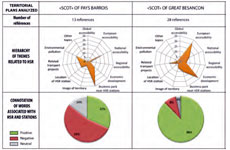
Categorías
Publicaciones
A methodological approach to analyze the territorial appropriation of high-speed rail from interactions between actions and representations of local actors
5/7/2018

In response to the difficulties in discriminating the specific transport impact from other factors influencing economic and spatial development, researchers are now focusing more on understanding the process by which territorial changes occur to explain how economic and social agents and local authorities have appropriated the new transportation system. This appropriation plays a crucial part in the territorial dynamics. The diversity of economic and spatial changes produced by highspeed rail indicates the existence of multiple modes of appropriation which vary according to the location of stations, the mobilization of local stakeholders confronted with the transport operators’ logic and the geographical and historical context of the infrastructure implementation.
Appropriation is defined as a dialogical and identity process that must be explained in order to facilitate the understanding of the gradual and mutual adjustments between the transportation system and the territory. The analysis of the mechanisms of high-speed rail transport appropriation opens up new research opportunities in the quest to respond to a three-pronged issue:
- firstly, the issue of improving the understanding of the relation between the agents involved in the territorialization of the transport infrastructure by analyzing the interrelation between transport practices, the functioning of firms and development projects;
- Secondly, the issue of observing the “image” effect linked to the individual and collective representations of high-speed rail;
- and lastly, the issue of examining the temporal dimension of the territorialization process.
Thus, my contribution rests on the conception of an analysis grid to explain how appropriation has gradually taken shape throughout the various stages of the high-speed line project. Inspired by Brunel and Roux‘s research work on consumers’ habits, this analytical grid aims at reporting on the modes of HSR appropriation, emphasizing the temporality of the process. Appropriation is, in fact, a long-term evolutionary process which has started long before the implementation of the new infrastructure and continues even after the trivialization of its uses.
Descargar artículo (pdf) »


